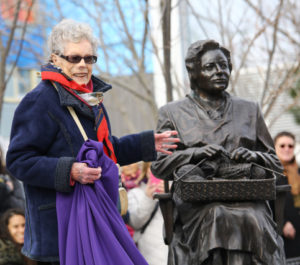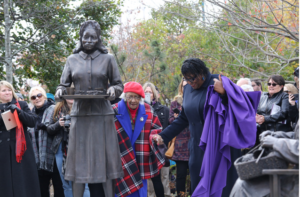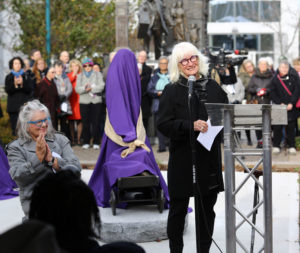Almost one year ago, on an unseasonably pleasant November morning, the Halifax Women’s History Society unveiled the bronze statues of “The Volunteers/Les Bénévoles” to a crowd of several hundred: VIP guests, supporters and funders, and several of the women we wished to honour. “The Volunteers/Les Bénévoles” is a life-sized group of three women—one elderly, one young adult, one a girl—two with European features, and one African-Nova Scotian. These bronze women represent countless hours of volunteer work, first of women during the Second World War, and then, 75 years later, of the members of the Halifax Women’s History Society.
The volunteers honoured by the statue were the women of Halifax, and Nova Scotia, and Canada who during the Second World War cooked, knitted, raised money, entertained troops, provided nursing care, and so much more. As we planned, fund-raised, and celebrated, we were blessed, and inspired, to have some of these women among us. During the war, Margaret Gordon, mother of one of our board members, served food and performed with Portia White’s choir at the Gerrish Street Hall, a segregated space for African-Canadian servicemen. Charlotte Guy-Jeffries and Helen Colwell both performed for troops, and actually met for the first time in seventy years at the project launch event. Charlotte shared her story of travelling by launch to a troop ship waiting in the harbour, climbing up a ladder on the side of the ship, in the winter, in the dark, in a cocktail dress and heels, to play the accordion for troops waiting to ship out. Joyce Purchase worked four hour shifts at the North End Canteen after school, and gathered scrap, and Margaret Lindsay, an important start-up donor, also volunteered. Their work was myriad, enormous, and went on for years. It was carried out in segregated contexts but by diverse women. Having some of the women who did this work with us grounded the thinking and focussed the intent of this monument: it is representative of a collective effort of actual, historical (and living) women: real, diverse, and inevitably flawed. These women who volunteered time when their lives also demanded more of them, pushed at the limits their society placed on them to accomplish what they felt needed to be done, and shaped events as they could.
In the hands of the elderly woman knitting, there is a basket that was made by Mi’kmaw elder, Margaret Pelletier. This small element is all we have to represent the Indigenous women who dealt with the impacts of the war, and rose to the challenges it created as well. It is a story that needs its own space, but the intricate basket, a masterpiece of Margaret Pelletier’s work, carefully rendered in bronze by the artist Marlene Hilton Moore, keeps a place for the story we haven’t yet told.
The placing of the monument represented as well, countless hours of volunteer work, fundraising, speaking, raising awareness, and as well as researching and writing. The parallel was not lost on the Society, all women. Dr. Janet Guildford, Dr. Frances Gregor, and Dr. Sharon MacDonald as researchers identified the massive amount of volunteer work done by women that was not visible in war commemorations. Their work highlighted the value of volunteer labour for making possible Canada’s participation in the war, and Halifax’s surviving the turmoil created by hundreds of thousands of soldiers passing through. (Yes, there was a riot at the end of the war, but the efforts of Haligonian volunteers had kept a lid on the powder keg of thousands of young men away from home for the first time, etc, for years at the point.) Guildford, Gregor, and MacDonald’s research also demonstrated the limits of gender and race imposed on the women of Halifax as they tried to organize, and the effort they made to circumvent those limits.
Photos by Bruce Bottomley
A year after the unveiling, our board has changed as the most senior members have taken well-deserved retirements, although Janet Guildford remains involved as past chair. The Board held a day-long retreat last spring to redefine our mandate now that the monument is in place. Sharon, the current chair was happy to point out that the newly-elected board has one member born in each decade from the 1940s to the 1990s. We are students, professors, historians, recent grads, and those passionate about history and about feminism. As we reviewed our mandate we quickly agreed that we were proud to define the organization as feminist and agreed unanimously that feminism speaks to the experience of all who identify themselves as women. We also agreed that we are committed to public history. We recognize that diversity is something we have to work toward, and that in so doing, we need to do the work. We intend to reach out to organizations that address women’s experiences from perspectives that have been marginalized to support their work, hoping to be a resource, rather than to add to the pressures on over-taxed community volunteers. At the same time, we will always maintain our commitment to fostering a diverse board and membership.
In the discussion to define durable operating procedures, Sharon MacDonald, in her role as chair, introduced the Board to a consensus model that she had experienced in other volunteer work, through the Quakers. It is a departure and a challenge, perhaps, but we have embraced it. We knew that “Robert’s Rules of Order” were not for us. This means that we will work to have all board members in support of everything we do, rather than just a simple majority. So far, so good, as it was very easy for the entire board to agree that lending support to the Xara Choral Theatre’s tour of “Fatty Legs,” was a natural fit. Their production tells the story of Residential School survivor Margaret Pokiak, and involved Indigenous artists and educating settler artists, and audiences.
For the Society, from the start, the goal of creating a permanent, or as permanent as possible, monument to women’s historical contributions, using the medium of bronze, was our unifying and over-riding objective. It was, literally, a monumental task, and this group of women volunteers got it done in under five years. We all love to take a stroll on the Halifax waterfront to visit the women. My favourite comment about the work was, “They speak to you.” The beautiful sculptures, created by Marlene Hilton Moore, are so animated and lifelike, they are approachable, touchable, and for many, they speak.
With that behind us, and a clear, inclusive, and ambitious public history mandate in front of us, we all look forward to fostering and helping to create better, more meaningful, and inclusive feminist public history in Halifax, and in Nova Scotia.
To learn more about the Halifax Women’s History Society, see our webpage and you can follow us on Facebook and Twitter.
Anne Marie Lane Jonah, historian with Parks Canada, has been an HWHS board member since 2016.



